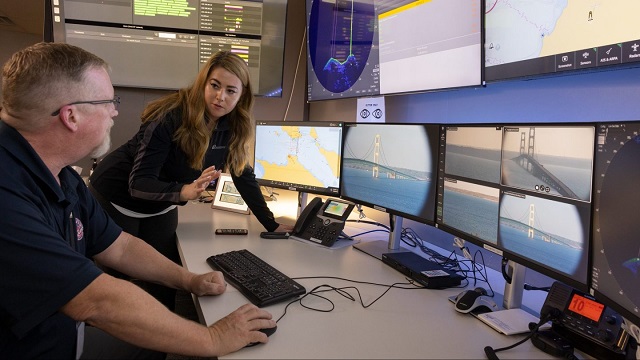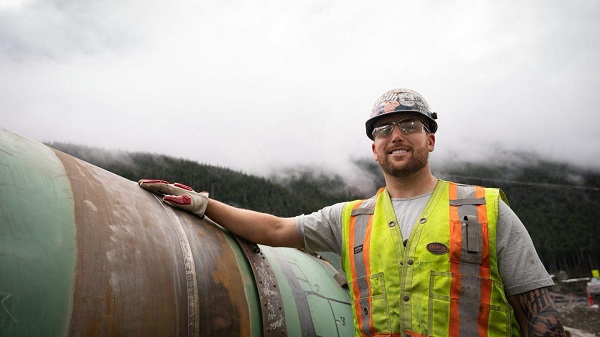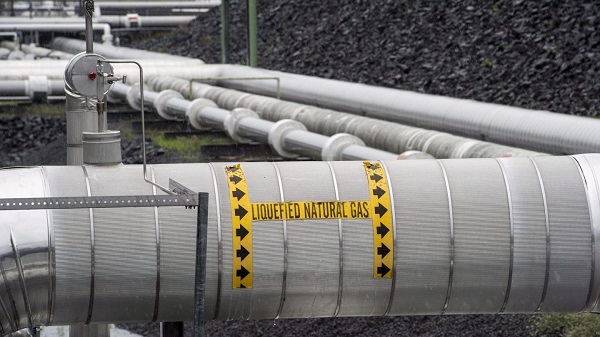Canadian Energy Centre
Critical energy project approved in positive sign for Ontario, Quebec and Michigan

Inside the Enbridge Straits Maritime Operations Center at Michigan’s Straits of Mackinac. Photo courtesy Enbridge
From the Canadian Energy Centre
By Will Gibson
Michigan regulators give green light to Enbridge Line 5 tunnel
A key artery in the network supplying Michigan, Ontario and Quebec with essential petroleum products has cleared a critical hurdle to continue operations.
In December, Michigan’s Public Service Commission approved a US$500 million project to replace about seven kilometres of the existing Line 5 pipeline underwater in the Straits of Mackinac with a new pipeline housed in a concrete tunnel far beneath the lakebed.
“The commission recognized the reality, which is the public needs the Line 5 tunnel and the products it transports,” says Jason Hayes, director of environmental policy at the Mackinac Centre for Public Policy.
“This is how it is supposed to work, although it took more than three years to get there.”
An energy lifeline
The existing Enbridge Line 5 pipeline has operated since 1953. It moves up to 87 million litres of crude oil and natural gas products for use daily between Superior, Wisconsin and Michigan, Ohio, Ontario and Quebec.
“The average person doesn’t always understand how crucial it is. We do in Sarnia,” says Scott Archer, business agent for UA 663, a local union that representing pipe fitters and welders who work in refineries and petrochemical facilities in Sarnia, Ontario.
“Line 5 is the lifeline for Ontario and also provides feedstock for refineries in Quebec. All of our refineries receive their feedstock from it. It’s what provides vehicle fuel for private and public transportation. Trucking and the railroads rely on it. Our agriculture industry uses it to dry crops.”
 Artist’s rendering of the Line 5 tunnel project proposed by Enbridge to protect the pipeline under the Great Lakes. Photo courtesy Enbridge
Artist’s rendering of the Line 5 tunnel project proposed by Enbridge to protect the pipeline under the Great Lakes. Photo courtesy Enbridge
The 1,600 members of UA 663 understand that continued operation of Line 5 doesn’t just affect them or their families, Archer says.
“It’s really the entire region,” he says.
“We have 70,000 people who live in this town and almost all of them depend on Line 5 to feed their families and keep a roof over their head.”
The project approval means just as much in Michigan and Ohio, where the Enbridge network supplies refineries in Detroit and Toledo, as well as propane throughout the region.
“Michigan uses more propane than any other state in the lower 48,” Hayes says.
“About 55 per cent of the propane that heats homes and cooks food in our state goes through Line 5 and comes from Sarnia. Half of the jet fuel used at the Detroit International Airport comes from Line 5 feedstock. It’s essential to keep our state going.”
 Aerial images of Michigan’s Straits of Mackinac, the communities of St. Ignace and Mackinaw City, and the Mighty Mac bridge spanning the Straits. Photo courtesy Enbridge
Aerial images of Michigan’s Straits of Mackinac, the communities of St. Ignace and Mackinaw City, and the Mighty Mac bridge spanning the Straits. Photo courtesy Enbridge
Additional approvals required
The tunnel project will need the approval of the Army Corps of Engineers at the federal level before Enbridge can start construction. The Army Corps is completing its environmental impact assessment, expected for completion in 2026.
Michigan’s attorney general Dana Nessel also continues to pursue court action in an effort to shut Line 5 down.
“The commission’s decision is still a big win,” Hayes says.
“[It] acknowledges the reality for regular people in Michigan and Ontario, who need fossil fuels, and the products made from them, in their day-to-day lives right now. It makes no sense to oppose a project that seeks to make it safer to transport them.”
2025 Federal Election
Canada’s pipeline builders ready to get to work

From the Canadian Energy Centre
“We’re focusing on the opportunity that Canada has, perhaps even the obligation”
It was not a call he wanted to make.
In October 2017, Kevin O’Donnell, then chief financial officer of Nisku, Alta.-based Banister Pipelines, got final word that the $16-billion Energy East pipeline was cancelled.
It was his job to pass the news down the line to reach workers who were already in the field.
“We had a crew that was working along the current TC Energy line that was ready for conversion up in Thunder Bay,” said O’Donnell, who is now executive director of the Mississauga, Ont.-based Pipe Line Contractors Association of Canada (PLCAC).
“I took the call, and they said abandon right now. Button up and abandon right now.
“It was truly surreal. It’s tough to tell your foreman, who then tells their lead hands and then you inform the unions that those three or four or five million man-hours that you expected are not going to come to fruition,” he said.

Workers guide a piece of pipe along the Trans Mountain expansion route. Photograph courtesy Trans Mountain Corporation
“They’ve got to find lesser-paying jobs where they’re not honing their craft in the pipeline sector. You’re not making the money; you’re not getting the health and dental coverage that you were getting before.”
O’Donnell estimates that PLCAC represents about 500,000 workers across Canada through the unions it works with.
With the recent completion of the Trans Mountain expansion and Coastal GasLink pipelines – and no big projects like them coming on the books – many are once again out of a job, he said.
It’s frustrating given that this could be what he called a “golden age” for building major energy infrastructure in Canada.
Together, more than 62,000 people were hired to build the Trans Mountain expansion and Coastal GasLink projects, according to company reports.
O’Donnell is particularly interested in a project like Energy East, which would link oil produced in Alberta to consumers in Eastern and Atlantic Canada, then international markets in the offshore beyond.
“I think Energy East or something similar has to happen for millions of reasons,” he said.
“The world’s demanding it. We’ve got the craft [workers], we’ve got the iron ore and we’ve got the steel. We’re talking about a nation where the workers in every province could benefit. They’re ready to build it.”

The “Golden Weld” marked mechanical completion of construction of the Trans Mountain Expansion Project on April 11, 2024. Photo courtesy Trans Mountain Corporation
That eagerness is shared by the Progressive Contractors Association of Canada (PCA), which represents about 170 construction and maintenance employers across the country.
The PCA’s newly launched “Let’s Get Building” advocacy campaign urges all parties in the Canadian federal election run to focus on getting major projects built.
“We’re focusing on the opportunity that Canada has, perhaps even the obligation,” said PCA chief executive Paul de Jong.
“Most of the companies are quite busy irrespective of the pipeline issue right now. But looking at the long term, there’s predictability and long-term strategy that they see missing.”
Top of mind is Ottawa’s Impact Assessment Act (IAA), he said, the federal law that assesses major national projects like pipelines and highways.
In 2023, the Supreme Court of Canada found that the IAA broke the rules of the Canadian constitution.
The court found unconstitutional components including federal overreach into the decision of whether a project requires an impact assessment and whether a project gets final approval to proceed.
Ottawa amended the act in the spring of 2024, but Alberta’s government found the changes didn’t fix the issues and in November launched a new legal challenge against it.
“We’d like to see the next federal administration substantially revisit the Impact Assessment Act,” de Jong said.
“The sooner these nation-building projects get underway, the sooner Canadians reap the rewards through new trading partnerships, good jobs and a more stable economy.”
Canadian Energy Centre
First Nations in Manitoba pushing for LNG exports from Hudson’s Bay

From the Canadian Energy Centre
By Will Gibson
NeeStaNan project would use port location selected by Canadian government more than 100 years ago
Building a port on Hudson’s Bay to ship natural resources harvested across Western Canada to the world has been a long-held dream of Canadian politicians, starting with Sir Wilfred Laurier.
Since 1931, a small deepwater port has operated at Churchill, Manitoba, primarily shipping grain but more recently expanding handling of critical minerals and fertilizers.
A group of 11 First Nations in Manitoba plans to build an additional industrial terminal nearby at Port Nelson to ship liquefied natural gas (LNG) to Europe and potash to Brazil.
Robyn Lore, a director with project backer NeeStaNan, which is Cree for “all of us,” said it makes more sense to ship Canadian LNG to Europe from an Arctic port than it does to send Canadian natural gas all the way to the U.S. Gulf Coast to be exported as LNG to the same place – which is happening today.
“There is absolutely a business case for sending our LNG directly to European markets rather than sending our natural gas down to the Gulf Coast and having them liquefy it and ship it over,” Lore said. “It’s in Canada’s interest to do this.”
Over 100 years ago, the Port Nelson location at the south end of Hudson’s Bay on the Nelson River was the first to be considered for a Canadian Arctic port.
In 1912, a Port Nelson project was selected to proceed rather than a port at Churchill, about 280 kilometres north.
The Port Nelson site was earmarked by federal government engineers as the most cost-effective location for a terminal to ship Canadian resources overseas.
Construction started but was marred by building challenges due to violent winter storms that beached supply ships and badly damaged the dredge used to deepen the waters around the port.
By 1918, the project was abandoned.
In the 1920s, Prime Minister William Lyon MacKenzie King chose Churchill as the new location for a port on Hudson’s Bay, where it was built and continues to operate today between late July and early November when it is not iced in.
Lore sees using modern technology at Port Nelson including dredging or extending a floating wharf to overcome the challenges that stopped the project from proceeding more than a century ago.
He said natural gas could travel to the terminal through a 1,000-kilometre spur line off TC Energy’s Canadian Mainline by using Manitoba Hydro’s existing right of way.
A second option proposes shipping natural gas through Pembina Pipeline’s Alliance system to Regina, where it could be liquefied and shipped by rail to Port Nelson.
The original rail bed to Port Nelson still exists, and about 150 kilometers of track would have to be laid to reach the proposed site, Lore said.
“Our vision is for a rail line that can handle 150-car trains with loads of 120 tonnes per car running at 80 kilometers per hour. That’s doable on the line from Amery to Port Nelson. It makes the economics work for shippers,” said Lore.
Port Nelson could be used around the year because saltwater ice is easier to break through using modern icebreakers than freshwater ice that impacts Churchill between November and May.
Lore, however, is quick to quell the notion NeeStaNan is competing against the existing port.
“We want our project to proceed on its merits and collaborate with other ports for greater efficiency,” he said.
“It makes sense for Manitoba, and it makes sense for Canada, even more than it did for Laurier more than 100 years ago.”
-

 2025 Federal Election1 day ago
2025 Federal Election1 day agoOttawa Confirms China interfering with 2025 federal election: Beijing Seeks to Block Joe Tay’s Election
-

 Energy2 days ago
Energy2 days agoIndigenous-led Projects Hold Key To Canada’s Energy Future
-

 2025 Federal Election1 day ago
2025 Federal Election1 day agoHow Canada’s Mainstream Media Lost the Public Trust
-

 Energy2 days ago
Energy2 days agoMany Canadians—and many Albertans—live in energy poverty
-

 2025 Federal Election18 hours ago
2025 Federal Election18 hours agoBREAKING: THE FEDERAL BRIEF THAT SHOULD SINK CARNEY
-

 Business2 days ago
Business2 days agoCanada Urgently Needs A Watchdog For Government Waste
-

 2025 Federal Election1 day ago
2025 Federal Election1 day agoReal Homes vs. Modular Shoeboxes: The Housing Battle Between Poilievre and Carney
-

 2025 Federal Election19 hours ago
2025 Federal Election19 hours agoCHINESE ELECTION THREAT WARNING: Conservative Candidate Joe Tay Paused Public Campaign








